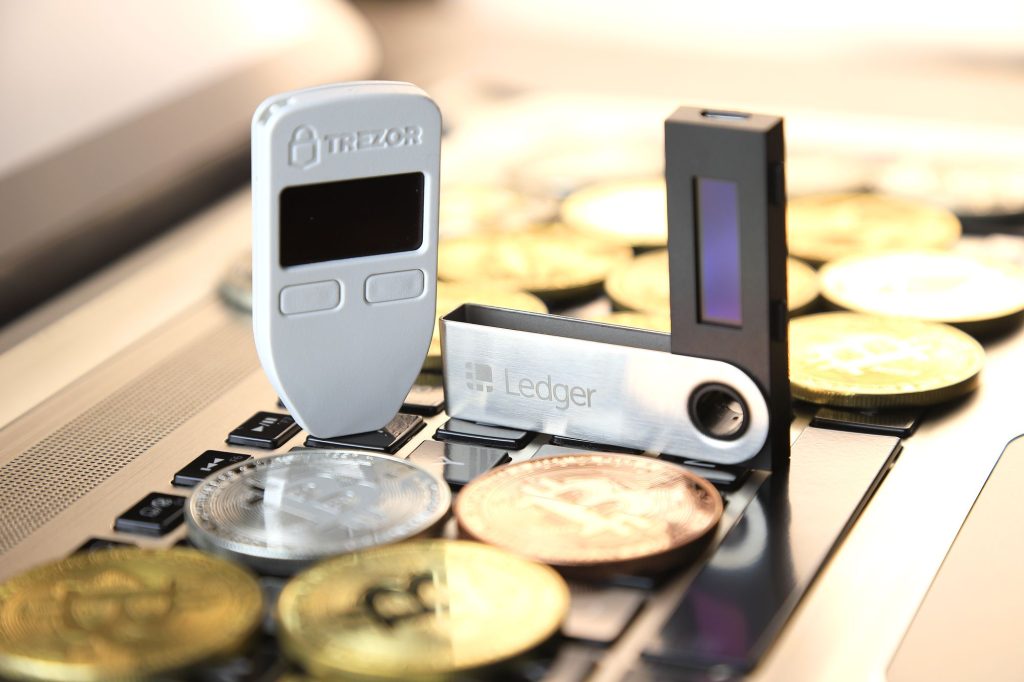Cryptocurrency security and protection of private keys are the most important aspects that cryptocurrency users should remember. In this guide, we will present an overview of hardware cryptocurrency wallets, such as Trezor and Ledger, and show you how to use them.
You can go directly to the topic that interests you:
- Cryptocurrency wallets
- Device overview
- Trezor installation and update
- Safety
- Creating and restoring backup
- PIN code
- Accounts and addresses
- Receiving cryptocurrencies
- Sending cryptocurrencies
- Summary
Cryptocurrency wallets
Cryptocurrency wallets are applications or devices that allow for secure storage of private keys and making transactions in cryptocurrencies, such as bitcoin, ethereum, or litecoin. With wallets, you gain full control over cryptocurrencies and can manage them in a way that best suits your needs.
We distinguish four types of wallets that allow storing private keys:
- hardware (hardware wallets)
- software (software wallets)
- online (web wallets)
- paper (paper wallets).
Hardware wallets provide the highest level of security and effectively protect private keys from hacker attacks and computer viruses. Although the prices of such wallets start at around 200 PLN, it is worth investing in them to ensure that our cryptocurrencies are safe.
Software wallets are a good compromise between security and convenience. These are free applications for mobile devices and computers. With software wallets, you can send and receive cryptocurrencies in a very simple way. A comparison of software cryptocurrency wallets can be found at the link: https://quark.house/2023/04/12/jak-wybrac-i-zalozyc-portfel-kryptowalut-na-smartfonie/
Online wallets are easy-to-use, closed applications of private companies. Unfortunately, they do not allow managing keys. Therefore, we advise against storing cryptocurrencies on exchanges and closed online wallets, for example, in the Revolut app wallet.
Mobile applications for storing cryptocurrencies and hardware wallets go hand in hand with paper wallets, on which the so-called seed or recovery phrase is written. In the “security” section, we will explain in detail what a seed is and how it works.
Device overview
When choosing devices for storing cryptocurrencies, it is worth paying attention to several key aspects:
- the popularity of the device
- whether the application software is open source or closed code
- who creates the device, whether the software is developed and updated regularly
- which cryptocurrencies and tokens are supported
- whether the device has additional features, such as a password manager and whether it can be used for two-factor authentication
- whether the application is compatible with hardware wallets.
We invite you to familiarize yourself with the list of the most popular hardware cryptocurrency wallets that provide the highest level of security and allow you to freely store your cryptocurrencies. Thanks to them, you can be sure that your funds are protected against hacker attacks and other threats. Choose the right wallet for yourself and enjoy the peace of mind that comes from knowing that your cryptocurrencies are always under your control.
| No. | Wallet name | Price | Supported cryptocurrencies | Additional information | Website |
| 1 | Trezor | 69 – 219 USD | 1289 (Model One), 1456 (Model T) | Open-source software, two models (One, Model T) | https://trezor.io/ |
| 2 | Ledger | 356 – 1304 PLN | 5000+ | Three models (Starx, Nano S, Nano X) | https://www.ledger.com/ |
| 3 | KeepKey | 49 USD | 40+ | Open-source software, integrated with Shapeshift | https://www.keepkey.com/ |
| 4 | BitBox02 | 139 USD | Bitcoin, Litecoin, Cardano, Ethereum, Chainlink, BAT, and ERC20 tokens | Open-source software, two models (Bitcoin, Multi) | https://shiftcrypto.ch/ |
| 5 | CoolWallet | 99 – 149 USD | 10,000+ / 12,000+ (12-27 blockchains) | Wireless (Bluetooth), slim design, two models (CoolWallet S, CoolWallet Pro) | https://www.coolwallet.io/ |
| 6 | Ellipal Titan | 79 – 139 USD | 1000+ | Open-source software, 2FA, two models (default and mini) | https://www.ellipal.com/ |
| 7 | Coldcard | 147.94 USD | Bitcoin | Open-source software | https://coldcard.com/ |
| 8 | OPOLO Cosmos | 198 EUR | 129 coins and 280,263 tokens | Open-source software | https://www.opolo.io/ |
| 9 | SecuX | 69 – 199 USD | 1000+ | Wireless, four models | https://secuxtech.com |
The most well-known cryptocurrency wallets are Trezor and Ledger. Trezor offers two models: One and Model T, while Ledger offers three: Starx, Nano S, and Nano X. The models mainly differ in terms of ease of use, memory, and supported blockchains. Both Trezor and Ledger can be used as password managers and 2FA devices.
Trezor installation and update
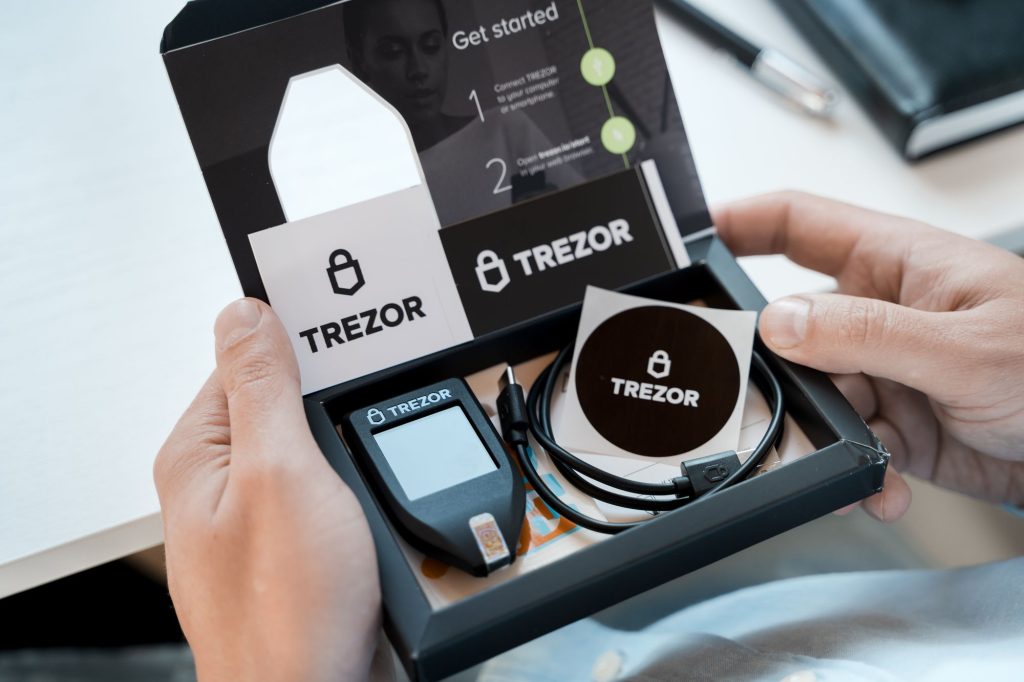
For security reasons, new devices are sold without pre-installed software. The first time you use it, you need to install the software on your Trezor device. To do this, download the Trezor Suite software from the website https://trezor.io/start . When you connect your new device, the application will guide you through the process of downloading and installing the latest software.
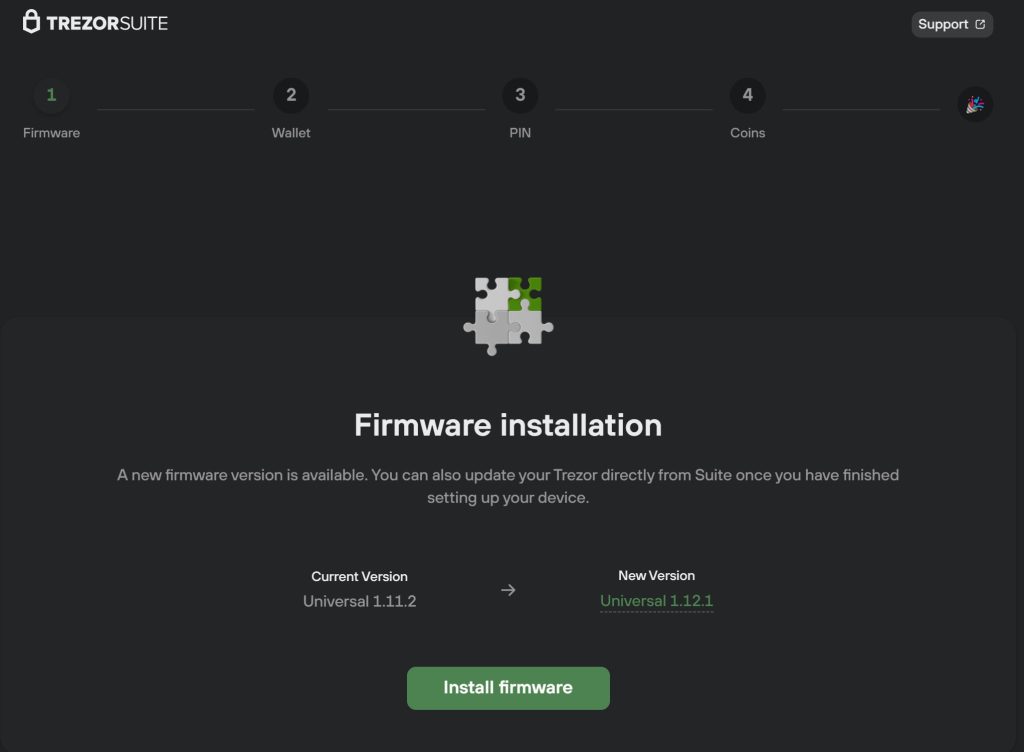
As new updates are released, the application will prompt you to install a newer version of the software. Warning! Updating the software may erase the keys from the device’s memory, so before proceeding with the update, make sure you have your recovery words (seed ) written down.
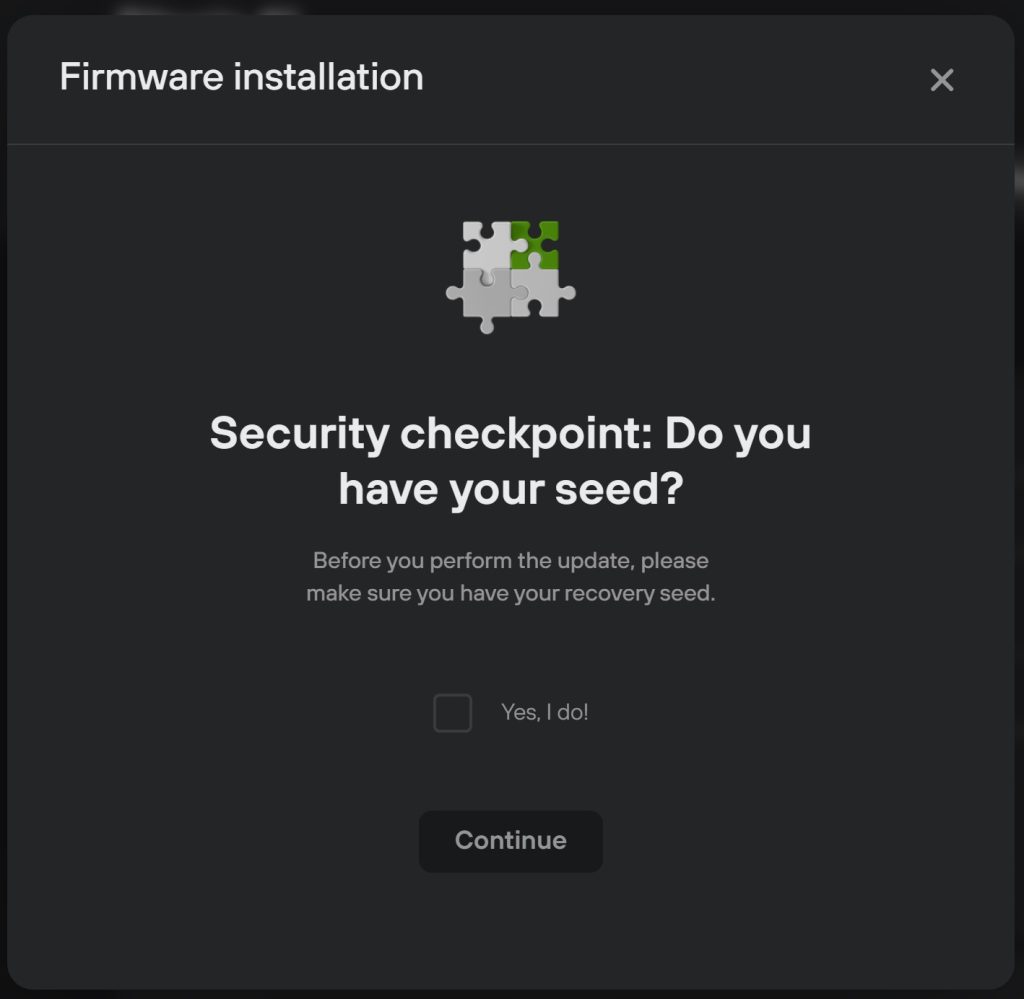
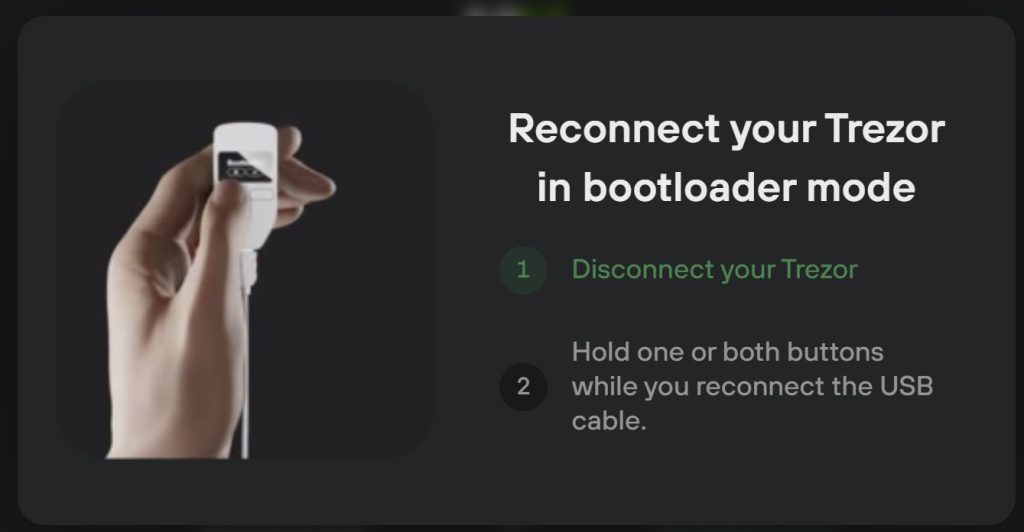
During the update, the program will ask you to connect the device in bootloader mode. To do this, when connecting the Trezor to a USB port, hold down one or both buttons on the Model One, or swipe your finger across the screen on the Model T. Follow the instructions and confirm the operation on the device.
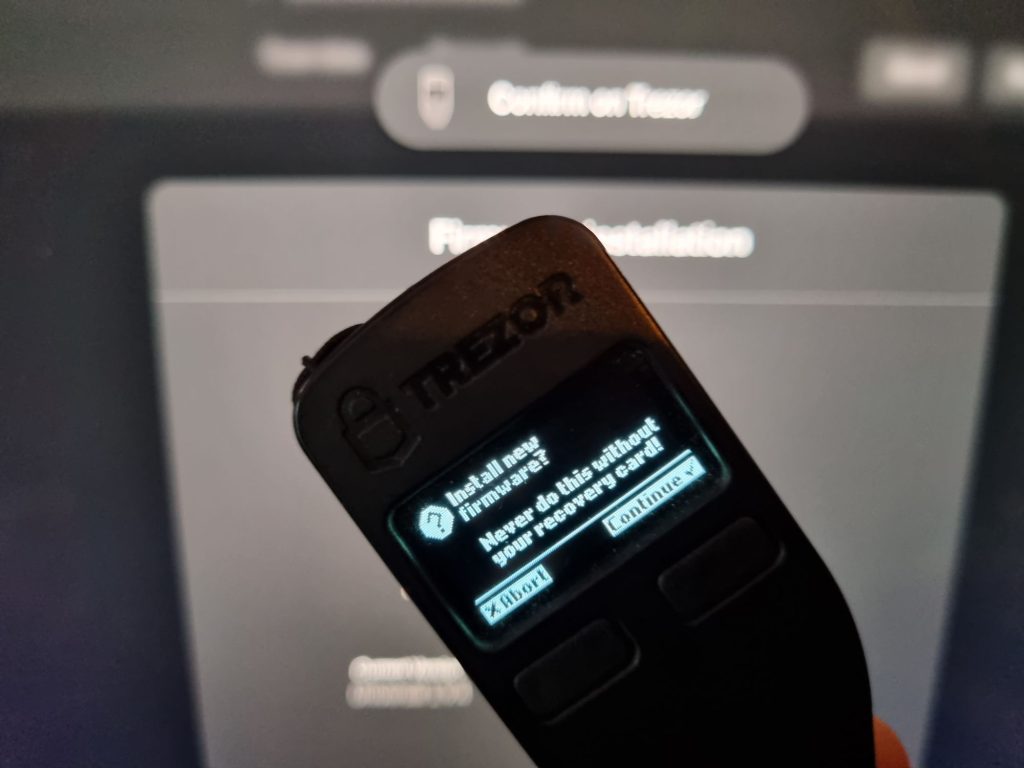
It’s time to set up or restore your wallet. For this purpose, the device will generate the so-called seed (recovery words).
Safety
The seed, or recovery words or phrase, is a unique sequence of 12, 18, or 24 English words generated during the creation of a cryptocurrency wallet. The user has no control over which words are generated.
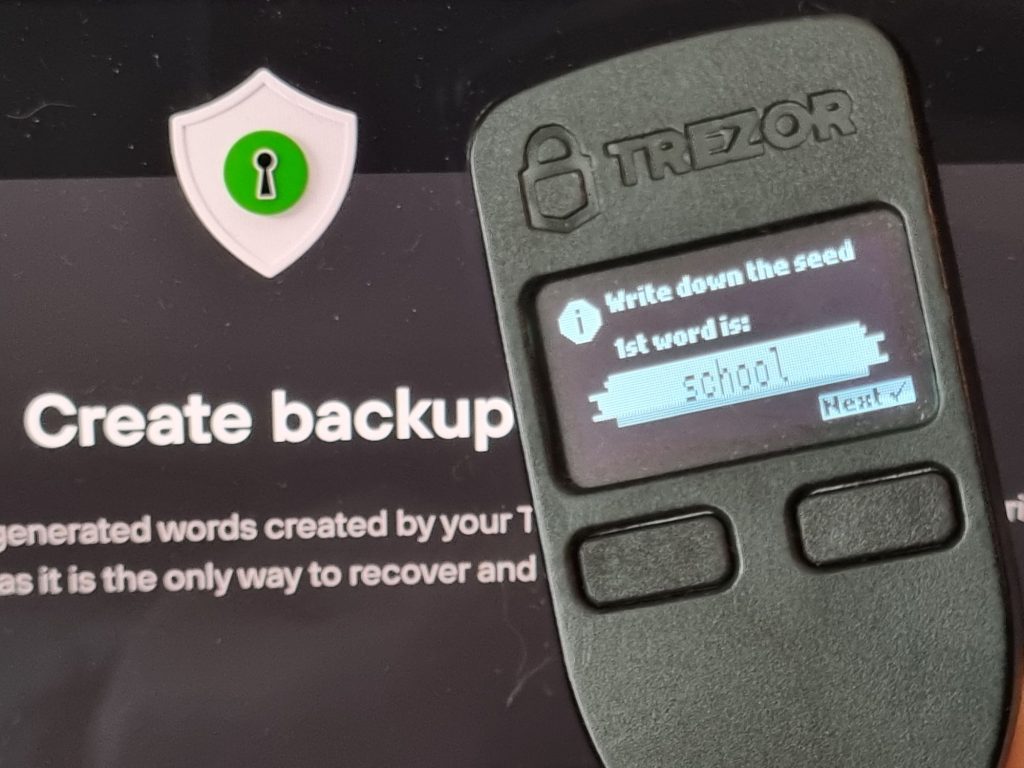
The seed is directly related to the private key of the wallet and serves as a tool to recover access to the funds associated with the addresses related to it.
The seed is created based on the BIP39 standard, which converts words from a standard dictionary into private keys. The seed serves as a backup and protects against loss of access to the wallet, for example, in the event of a device failure on which the wallet is installed.
Some users are afraid that someone might guess the words that make up their wallet. However, it is worth noting that the initial phrases generated by wallets that comply with the latest Bitcoin standards come from a list of 2048 unique words established under Bitcoin Improvement Proposal 39 or BIP39 (https://github.com/bitcoin/bips/blob/master/bip-0039/english.txt). Each word represents a range of bits in a long random number, which is your seed.
Words must be written in the correct order, and the number of possible combinations is so large that brute force attacks will be unprofitable as long as computers are made of something other than matter and occupy something other than space. It is almost impossible to generate two identical wallets.
Creating and restoring backup
After installing or updating the software, you can create a new wallet or restore a wallet for which you have saved the recovery phrase.
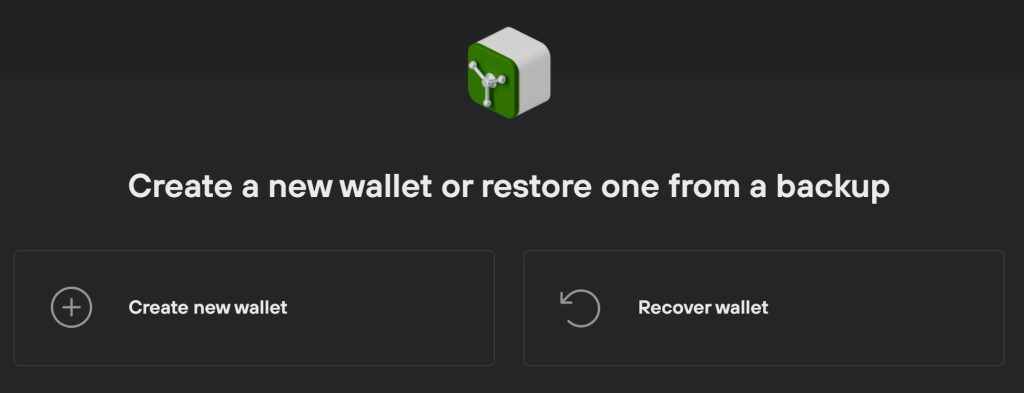
Then the device will display the seed. To secure the seed, it should only be written down with a pen on paper and stored in a safe place, inaccessible to others. You should not take screenshots or save the phrase on your computer, as this can result in the loss of your savings due to a computer virus or hacker attack.
It is important to remember responsibility and caution in the world of cryptocurrencies. The seed for a cryptocurrency wallet is crucial for the security of your funds, so you should not share it with anyone. In case of losing the seed, access to the wallet becomes impossible, and your investments will be lost.
You can download and print a free paper wallet template:
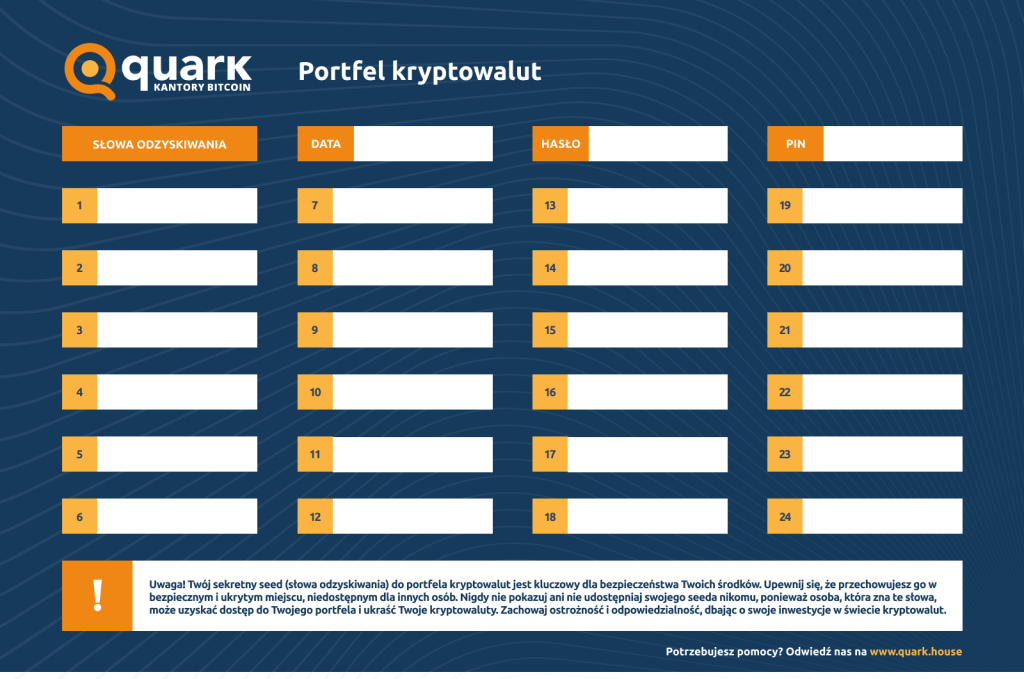
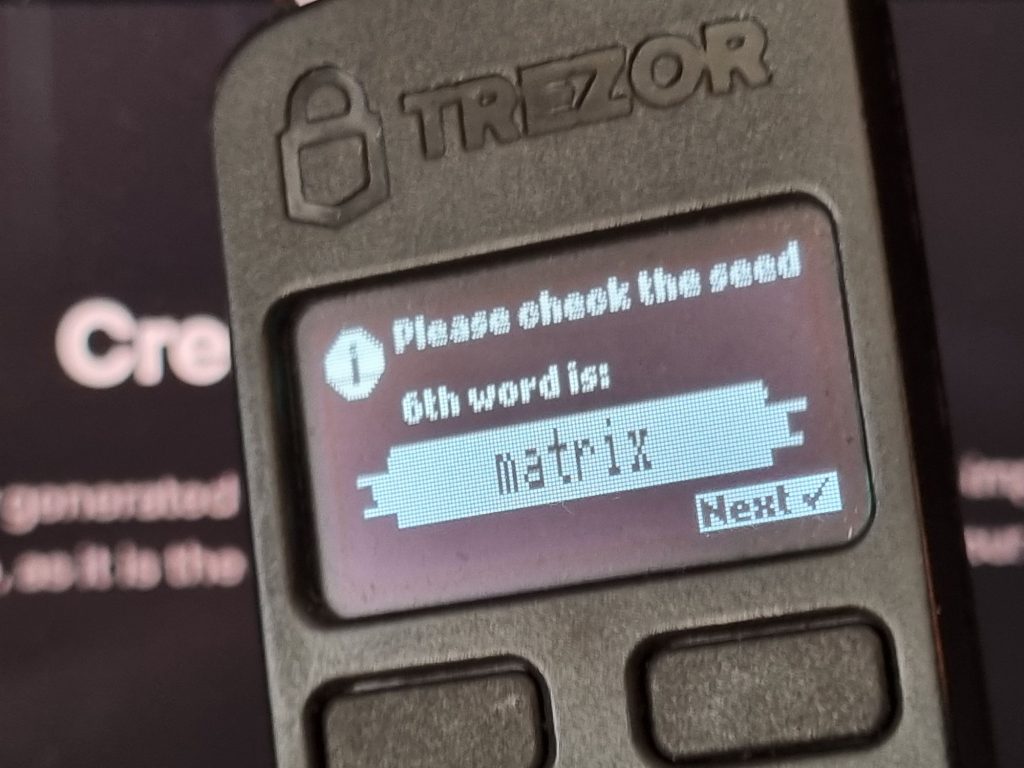
Once you have written down all 24 words, the application will display all the words again and ask you to check if you have written everything down correctly. Congratulations! The backup has been created. Remember that if you lose the recovery words, you will irretrievably lose access to your savings. You can always re-check if you have correctly written down the key phrase by going to the device settings in the Trezor Suite application.
After writing down all 24 words, the application will display them again and ask you to check if everything has been correctly saved. Congratulations! Your backup has been created. Remember that the lack of a seed means the irreversible loss of access to your savings.
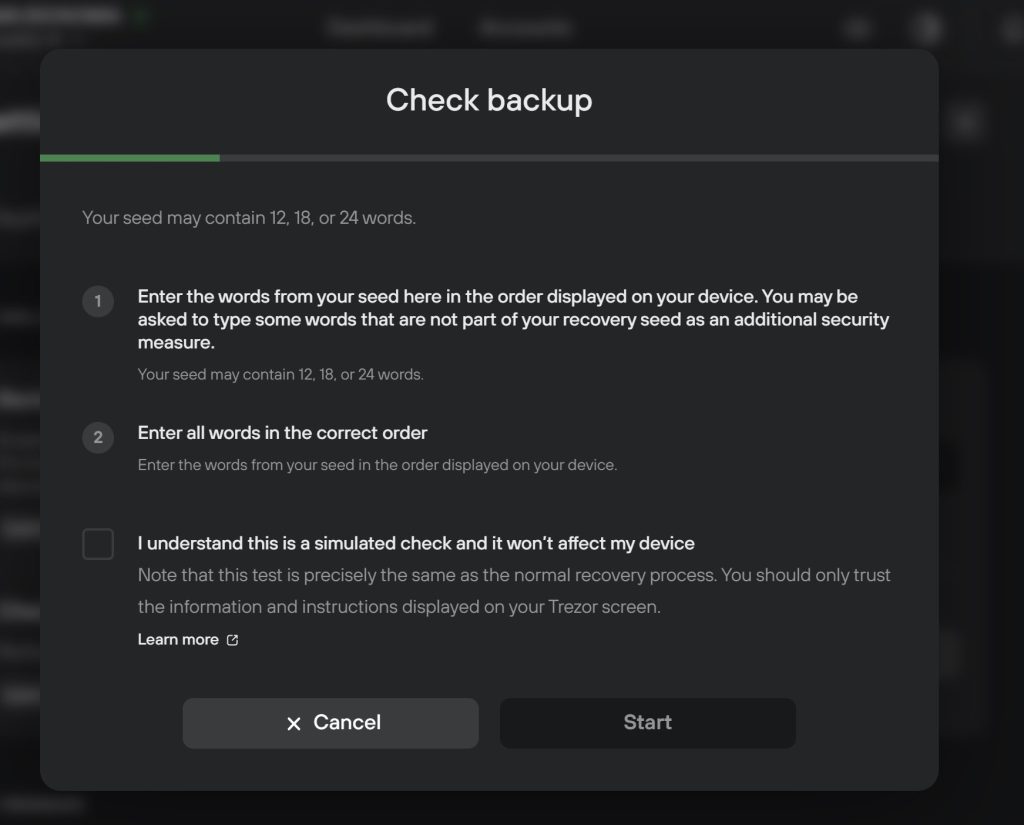
Therefore, it is worth saving the recovery words in several copies, laminating them, hiding them in an envelope, and depositing copies in bank vaults, walling them in a wall, or adding them to a will. We do not recommend tattooing the seed, as someone could see the tattoo and use it to appropriate your savings. An interesting idea for securely hiding the seed may be encoding it in your memory, however, we advise against this method, as it is easy to forget the wording of these words, and in case of an unfortunate accident, your loved ones will not have access to your savings.
If you don’t believe in the durability of paper or have significant cryptocurrency holdings, we recommend using dedicated products, such as cryptosteel – made of stainless steel, resistant to high temperatures and adverse atmospheric conditions.
If you have children and care about their economic and technological knowledge, this type of wallet will work perfectly as a treasure buried in the ground. You can create a map with challenges and teach children through play.
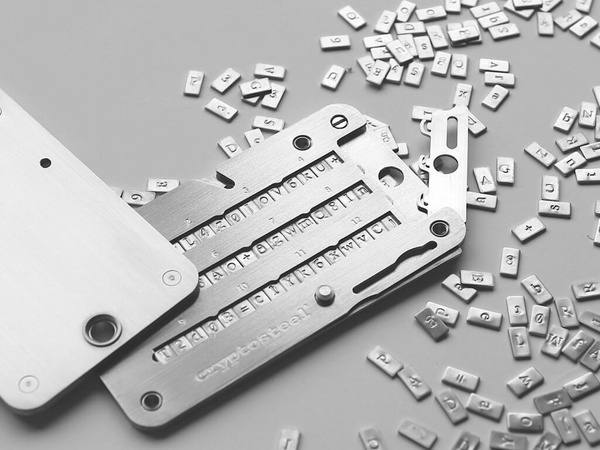
PIN code
During the configuration of a new device, in the next step, you will be asked to create a PIN code. The PIN code is essential for logging into the Trezor Suite application and authorizing transactions.
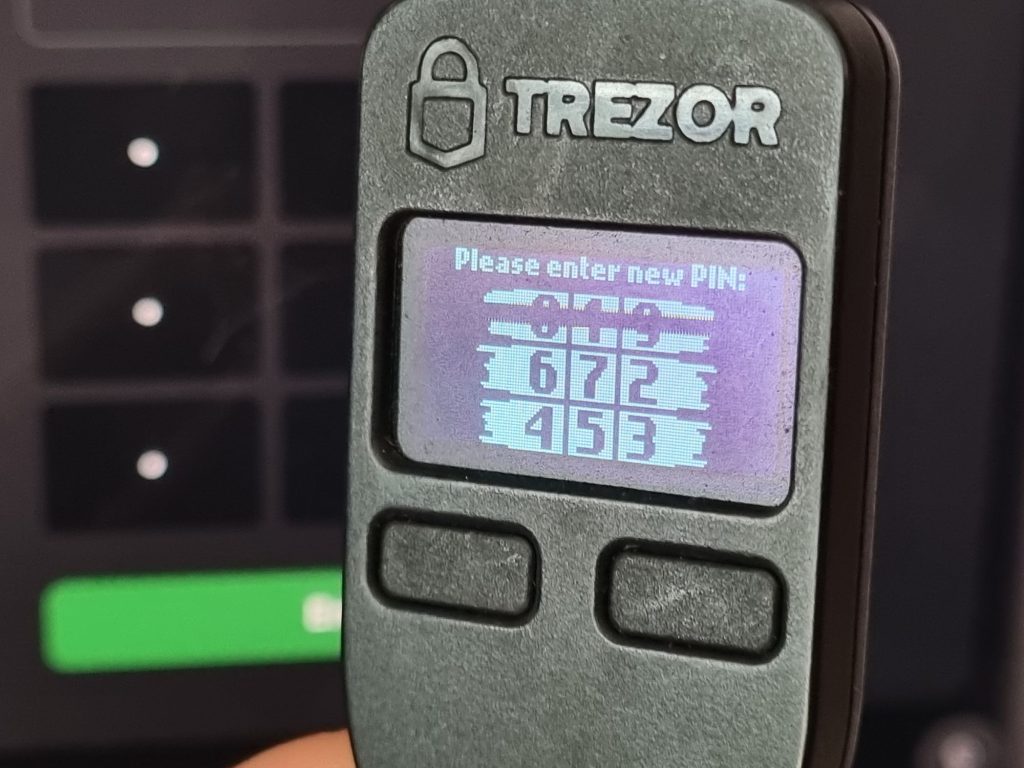
In the case of the T model, the PIN code consists of digits from 0 to 9 and is entered using the touchscreen. In the One model, the device displays digits from 0 to 9, and the user selects the appropriate fields on the computer screen. Digits are always displayed in random order. The PIN code can consist of up to 50 digits.
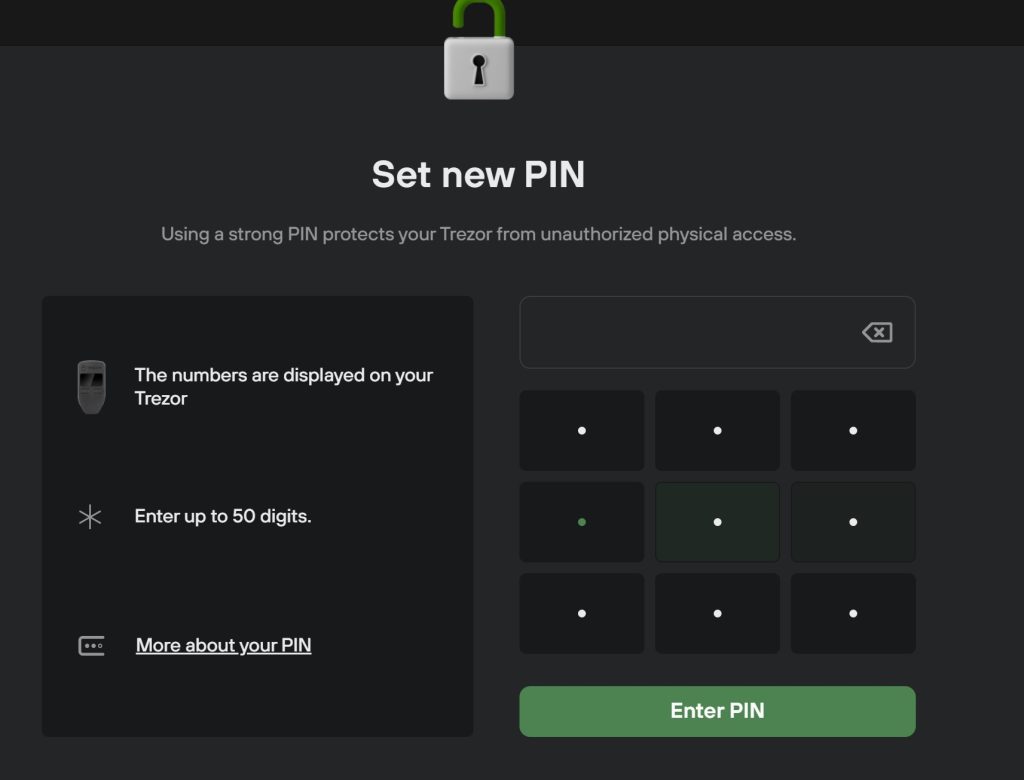
The PIN code can be changed in the Trezor Suite application settings. There is also the possibility of setting a password that will encrypt the seed. This will create a hidden wallet. Each hidden wallet can have an individual password, which cannot be changed or recovered in case of its loss or forgetfulness.

Accounts and addresses
In the last part of the configuration, the device will ask you to choose the blockchains you intend to use. Creating new accounts will be possible at any time.

You can create virtually an unlimited number of new addresses and accounts.
In the example below, we will add the cryptocurrency bitcoin to the wallet.
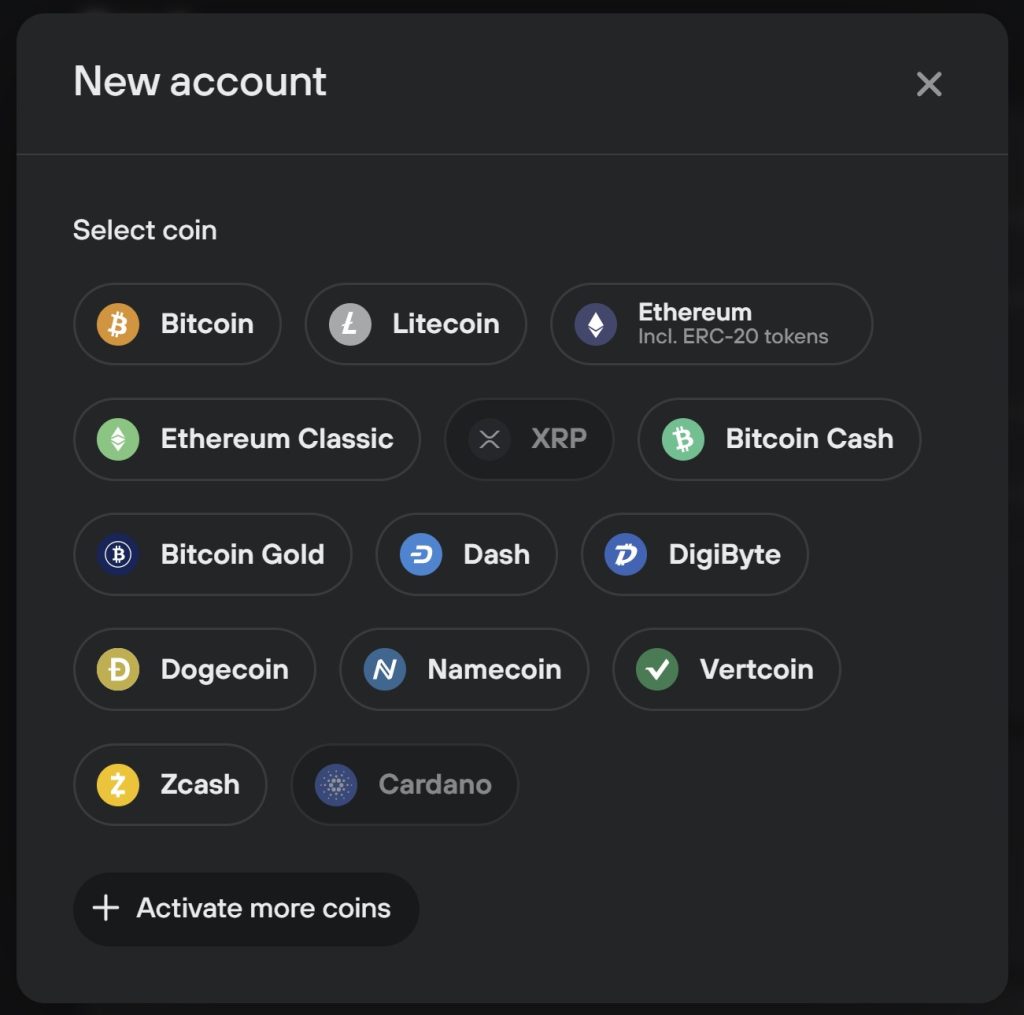
When creating an account, you will be asked to choose the type of account.
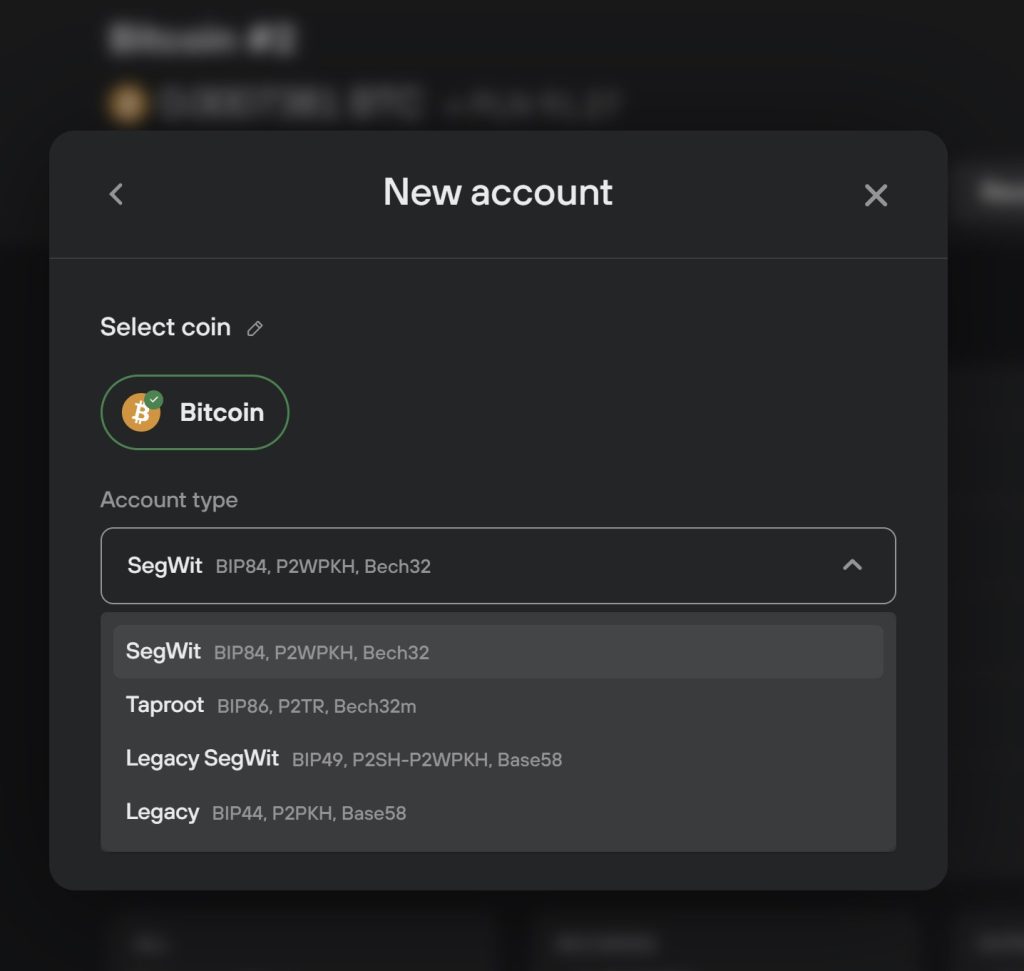
In the case of bitcoin, we distinguish four types of addresses:
- Default addresses (SegWit) start with “bc1…” and are the most efficient address format. They are not yet fully compatible with all types of services and wallets. However, it is worth using them wherever possible.
- Taproot addresses start with “bc1p…”. Taproot is a technically improved version of Segwit, and its addresses are encoded using a modified version of bech32, known as bech32m. Taproot addresses allow for more efficient transactions with lower fees and better privacy as adoption increases.
- Compatibility addresses (Legacy SegWit) start with “3…” and have good performance. They are compatible with virtually all services and wallets. Use this type of address if you cannot use the default address.
- Older addresses (Legacy) start with “1…”, are the least efficient as they do not use SegWit improvements. However, they still find application among users.
Receiving cryptocurrencies
To receive cryptocurrency, simply select the account you are interested in, and then click “Receive”.
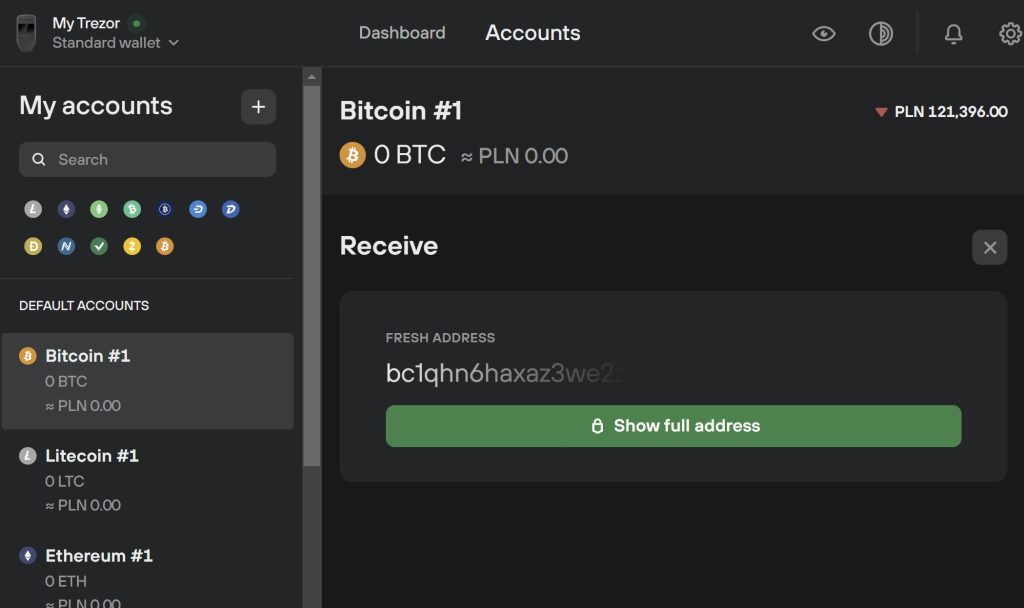
After clicking on “Show full address,” the device may ask for the PIN code. Then the address and QR code will appear on the screen. To make sure the address on the screen is correct and has not been changed by hackers, compare it with the address displayed on the device screen and confirm.

Sending cryptocurrencies
After selecting the account and clicking the “Send” button, a window will appear where you need to enter the transaction details.
After entering the address, you can set the amount of cryptocurrency to send or its value in fiat currency. You can also send all funds. The wallet also allows you to send cryptocurrency to multiple different addresses within a single transaction.

Before sending the transaction, the application will ask you to choose the priority. Transaction fees are calculated automatically based on average fees and network congestion. The user can specify how much they want to pay for the transaction.
- Choosing the “Low” option will result in adding the minimum fee. In this case, transaction confirmation may take an exceptionally long time.
- The “Normal” option allows you to add the optimal fee, and confirmation of such a transaction may take about an hour.
- Choosing the “High” option involves adding the highest fee, allowing the transaction to be confirmed in about 10 minutes.
- The “Custom” option allows you to independently determine the value of the fee per one byte of transaction data and is dedicated to advanced users.
Then, as part of the confirmation, the device will display a summary with the amount of cryptocurrency being sent and the destination address. Check if the address on the screen matches the address on the device and confirm.
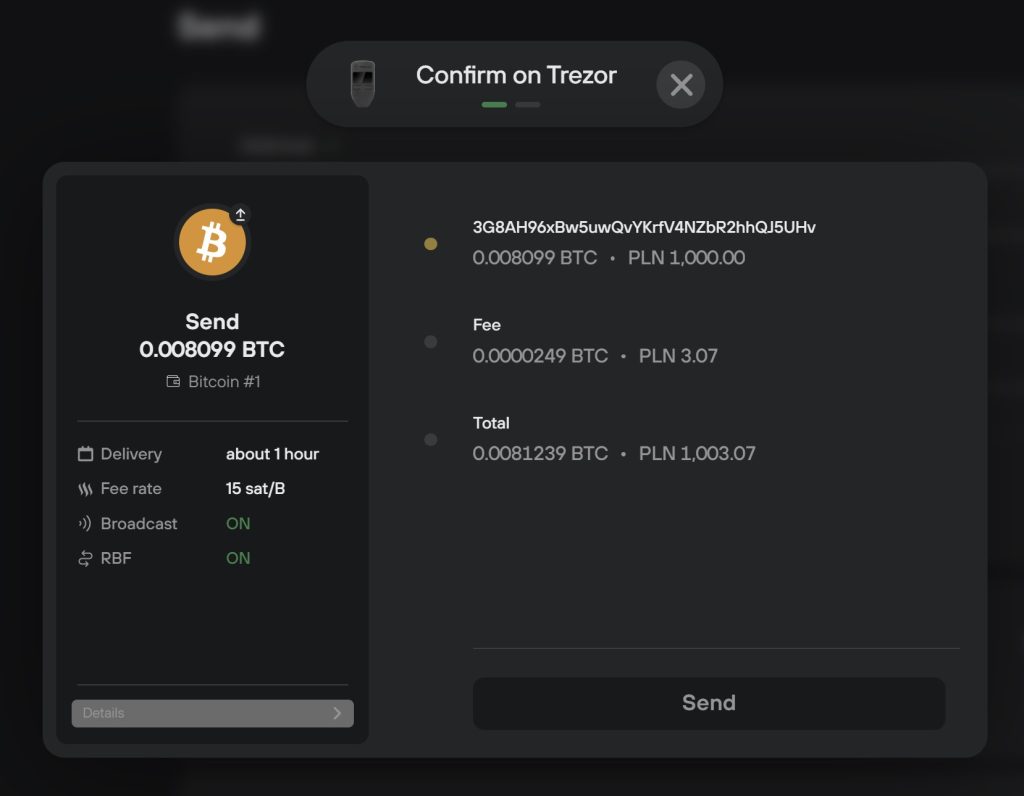
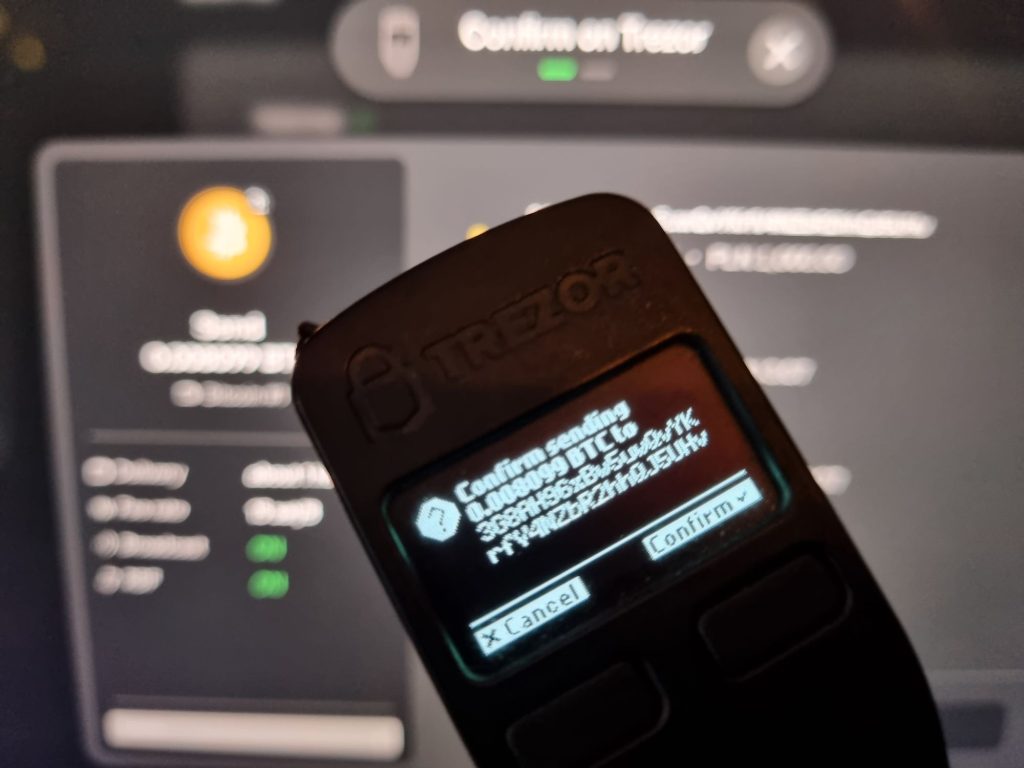
After confirming the operation on the device, click the “Send” button on the computer for the transaction to be sent to the network.
The transaction status on the network can be tracked in the block explorer. For Bitcoin, Trezor provides its own block explorer at https://btc1.trezor.io/, while for Ethereum, it is https://etherscan.io/.
Summary
Hardware wallets provide the best protection for your keys. With them, you can feel safe even if your computer is infected or hacked. There are many devices to choose from, with the most popular being Trezor and Ledger. Before starting to use the wallet, you must make a backup of the recovery words (seed). Without this, in case of loss of the device, the ability to recover cryptocurrencies from that wallet is lost. The key phrase should be stored in a secure and confidential place. Sending and receiving cryptocurrencies is straightforward.
Trezor allows you to buy and sell cryptocurrencies, but the rates and fees can be very unfavorable. Therefore, we invite you to visit the Quark brick-and-mortar cryptocurrency exchange, where you can buy and sell cryptocurrencies for cash, without the need to create an account and verify. If you need help setting up and configuring your wallet, our experts will assist you at no additional cost.
